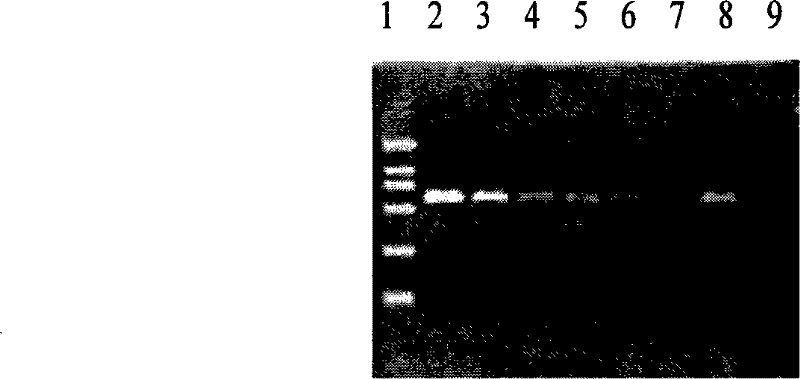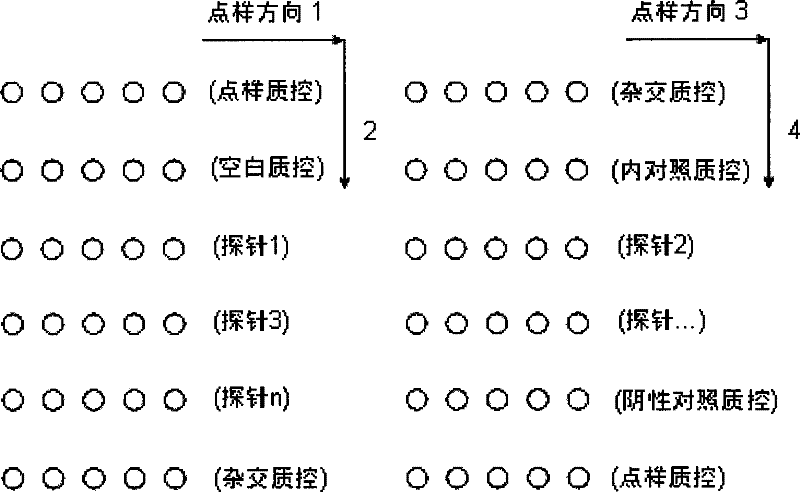Process for abstracting bacterial DNA from phlegm, kit and uses thereof
A bacterial nucleic acid and kit technology, applied in the direction of biochemical equipment and methods, microbial measurement/testing, resistance to vector-borne diseases, etc., can solve problems such as complex operations, long time-consuming, and difficulty in meeting clinical needs
- Summary
- Abstract
- Description
- Claims
- Application Information
AI Technical Summary
Problems solved by technology
Method used
Image
Examples
Embodiment 1
[0075] Example 1, the extraction of mycobacterium smegmatis nucleic acid in the sputum sample
[0076] 1. Take the sputum samples (provided by Beijing Municipal People's Hospital) of people whose acid-fast staining results are negative, and use them as test materials for future use.
[0077] 2. Into the above-mentioned sputum samples, the concentrations were respectively 10 2 -10 7 CFU / ml of M. smegmatis (American Type Culture Collection ATCC 700084) was used as a sputum sample for extraction of M. smegmatis nucleic acid.
[0078] 3. Add an equal volume of 20% (mass percentage) NaOH solution to the above-mentioned sputum samples mixed with different concentrations of Mycobacterium smegmatis, mix well, and liquefy at 37° C. for 30 minutes to obtain liquefied sputum.
[0079] 4. Take 1ml of the above liquefied sputum, centrifuge at 12000rpm for 5 minutes, and remove the supernatant; add 1ml of sterilized water containing 100mM EDTA, vortex and centrifuge at 12000rpm for 5 minu...
Embodiment 2
[0084] Embodiment 2, the identification of mycobacterial strain in sputum sample
[0085] 1. Extraction of mycobacterial nucleic acid in sputum samples
[0086]The mycobacterium-free sputum sample in Step 1 of Example 1 was used as the test material, and the concentration of 1×10 5 Mycobacterium tuberculosis (American Type Culture Collection ATCC27294) in CFU bacteria / ml, the nucleic acid of Mycobacterium tuberculosis in the sputum sample was extracted, and the specific nucleic acid extraction process was the same as in Example 1.
[0087] The mycobacterium-free sputum sample in Step 1 of Example 1 was used as the test material, and the sputum sample was mixed with a concentration of 1×10 5 CFU bacteria / ml Mycobacterium kansasii (American Type Culture Collection ATCC 12478), Mycobacterium intracellulare (American Type Culture Collection ATCC 13950), Mycobacterium chelonis (American Type Culture Collection ATCC 14472), Mycobacterium fortuitously (American Type Culture Collect...
Embodiment 3
[0104] Example 3, detecting whether the gene locus of Mycobacterium tuberculosis is mutant or wild type
[0105] 1. Extraction of Mycobacterium tuberculosis nucleic acid in sputum samples
[0106] Get the mycobacterium-free sputum sample in step 1 of Example 1 as the test material, and in this sputum sample, the concentration of 1 × 10 5 Mycobacterium tuberculosis (American Type Culture Collection ATCC27294) in CFU bacteria / ml, the nucleic acid of Mycobacterium tuberculosis in the sputum sample was extracted, and the specific nucleic acid extraction process was the same as in Example 1.
[0107] 2. Preparation of oligonucleotide primers and probes
[0108] The primers used for detecting whether the rpoB, katG, inhA, rrs and rpsL gene loci of Mycobacterium tuberculosis are mutant or wild type include primers for amplifying the rpoB, katG, inhA, rrs and rpsL genes of Mycobacterium tuberculosis, and the nucleotide The sequences are shown in Table 7. The probes used to detect w...
PUM
| Property | Measurement | Unit |
|---|---|---|
| diameter | aaaaa | aaaaa |
| diameter | aaaaa | aaaaa |
| diameter | aaaaa | aaaaa |
Abstract
Description
Claims
Application Information
 Login to View More
Login to View More - R&D
- Intellectual Property
- Life Sciences
- Materials
- Tech Scout
- Unparalleled Data Quality
- Higher Quality Content
- 60% Fewer Hallucinations
Browse by: Latest US Patents, China's latest patents, Technical Efficacy Thesaurus, Application Domain, Technology Topic, Popular Technical Reports.
© 2025 PatSnap. All rights reserved.Legal|Privacy policy|Modern Slavery Act Transparency Statement|Sitemap|About US| Contact US: help@patsnap.com



